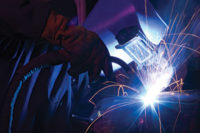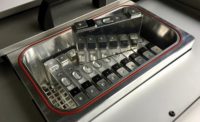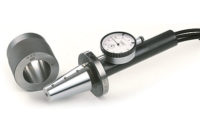In-process monitoring of welding operations to reduce the amount of destructive testing is more than a dream for one automobile seat manufacturer. Engineers at this Tier One supplier are looking at robotic cells that monitor the profiles of the signatures of key welding parameters. They hope that the ability to measure process variation reliably will allow them to control current, voltage, wire feed speed and gas flow more tightly and to test seats twice a week instead of once a day.
"At the end of the day, you really don't know the quality of the weld until you section it and look at grain structures or put it through shear and pull testing," says Mike Sharpe, product manager at Fanuc Robotics North America Inc. (Rochester Hills, MI), the builder supplying the welding cells. "Testing seats is expensive because you ruin a $40 to $100 assembly each time that you do it."
Fanuc Robotics has gone a step further to lessen the cost of doing so more than most other manufacturers of welding automation systems. Its engineers have developed a feedback and control scheme that exploits the latest generation of power supplies from Lincoln Electric Co. (Cleveland) and other manufacturers using microprocessor-controlled inverters. Fanuc's engineers have tapped the welding parameters that the power supplies collect and control in real time and tied it to the position of the torch's tip in space to create a signature of each parameter.
The scheme relies on three layers of software. At ground level, built-in microprocessors in Lincoln's Power Wave 455R and other similar power supplies monitor the arc physics and adjust welding parameters hundreds of Arial a second to maintain the desired arc forces and wave profiles in real time to improve performance. Arc length (voltage, in layman's terms) and current are at the heart of the control. In addition to ensuring the correct frequency and amplitude, the microprocessor uses these basic parameters to shape pulses and create a constant power output.
The second level of software, the Arc Data Monitor, overseeing Fanuc's ARC Mate 100i Model B robots, monitors all of the data, links each measurement with the robot tip's location in space and plots the measurements on a graph. Because a variety of configurable views display the feedback signals as functions of position, operators and engineers can pinpoint problem spots within a weld during inspection, troubleshooting and process improvement exercises. "The robot knows the exact position of voltage, current and other feedback measurements in space along the weld," says Sharpe.
Position is all
Relating welding parameters directly to position differentiates the Fanuc scheme from those of other vendors and makes it more precise, the company says. "Except for calculating power input, time really means nothing," says Sharpe. "Position is not always known in a time plot. For instance, most time-based software waits a predetermined amount of time for the arc to stabilize before it starts to move the torch. You don't know the point in the plot when it started moving."
Variations in velocity pose another problem with tracking welding parameters and position with time and trying to use time as the common variable to relate them. A weld or welding routine might consist of several inflection points at which velocity changes. If the robot moves the torch at 25 inches per minute initially and accelerates to 30 inches per minute along a section of thinner material, the variation introduces uncertainty into any interpolation calculations for linking welding parameters with the robot's position, according to Sharpe.
On the other hand, he says, signatures of welding parameters based on position are exact and useful for monitoring the quality of welds. Using the signatures is a matter of creating a good benchmark signature and looking for deviations from it during production. Software running in the robot's controller instructs the robot to take preprogrammed action--issue a warning, pause or stop--whenever one of the signatures exceeds the control limits. It also can upgrade that action when the parameter exceeds the limit for a specified amount of time.
Consider an application in which the current signature contains spikes that exceed the control limits for a short time. In this case, the initial action could be to issue a warning to the operator. "Even though a short-lived spike might occur, it does not necessarily mean that the weld is bad," Sharpe observes. "The power supply could be reacting to a condition in its environment to create a good weld." If the current were to exceed the limit for a longer time, then the controller could stop the robot and ask the operator to take corrective action.
For generating the benchmark signature and establishing control limits, Sharpe recommends a simple design of experiments for making representative good welds in a controlled environment and verifying their integrity through cross-section analyses and pull tests. He also suggests consulting the robot and welding equipment vendors for establishing control limits for the material, gas and wire composition.
A trained operator can scan the signature for clues about the problem. An erratic voltage signature with many spikes, for example, can denote a problem with gas or binding in the wire feeder. "Gas would cause voltage fluctuations because ionization of the gas is critical to the energy transfer," Sharpe explains. "Voltage would change from a sticking wire because a smooth, steady wire feed speed is necessary to keep the wire in the puddle."
A misfixtured part, for example, is a common reason for current to rise. Variation in the tip-to-work distance, whether from incorrect placement in a fixture or an excessive gap, can cause current to fluctuate, although power sources with microprocessor-controlled inverters can adjust the current to work correctly within a certain range. Thickness of the material could affect current readings too, but "it's unlikely that a variation [large enough to affect the signature noticeably] would get through the stamping or forming process, let alone fit in the welding fixtures," says Sharpe.
Useful data
The third level of software in Fanuc's quality control scheme is its ARCworks PRO package for monitoring production and troubleshooting problems at the cell level.
Introduced in June, the PC-based software can supervise several robots from a cell controller. Not only can it report the production and status of the robots connected to it in real time, but it also has a utility for highlighting problem welds and comparing production data from different robots, welds, shifts or days.
"The PC software shines when logging events over long periods and performing historical analyses," claims Sharpe. "It can collect vast amounts of data from the robots and conduct inquires that require memory capacity that the robot's controller doesn't have. For example, it can compare welds on every Friday for the last 20 weeks. In a shop with two robotic welding cells producing the same part, the software also can collect data from both cells and determine that the limits don't match. If Cell B is not making the same quality parts as Cell A, then the software can flag the morning report so the production manager can check on it."
Sharpe adds that tallying downtime and fault data and creating action reports is one of the software's strengths. "The old way to get this information for the plant manager in time for the 6:30 a.m. meeting was for the production manager to walk around with his notepad looking at production reports and the downtime logs, assuming that the operator wrote everything down," he explains. "Because the ARCworks PRO package queries the robots for this information and tallies the data automatically, the production manager can retrieve a list from the computer at 6:20 a.m., instead of coming in at 4 a.m. to get the data and figuring out what happened the night before."
Even though Fanuc launched a commercial version of the software recently, the software has been running at a beta site making formed rails, bumpers and structural chassis for the automobile industry. Sharpe reports that the Tier One supplier has had success in pinpointing the quality problems with particular welds, workcells and operators. The data have helped the welding operations to make a number of improvements to the process. One outcome was training operators in welding techniques, loading work into fixtures, and checking and validating setups and welds. Others include redesigning the upstream forming processes, optimizing material flow through the factory and considering whether ordering more wire automatically through the company's enterprise resource planning (ERP) system will improve throughput when the supply runs low.
Wire old units too
For manufacturers wanting to monitor the power supplies and welding robots already in their factories, Chris Anderson, product manager at Motoman Inc. (West Carrollton, OH), recommends fitting the robots with root mean square (RMS) sensors and sending the feedback to third-party software packages for analysis. The most commonly used RMS sensor is a Hall-effect sensor, which is essentially a magnet with a hole to slip over a welding lead. The current flowing through it excites the magnetic field to create a voltage of corresponding magnitude to the current. Circuitry uses the RMS of the feedback signal to differentiate a short, fat pulse from a tall, skinny one, even though the average current is the same.
These sensors are much more accurate than the low-grade current and voltage meters built into conventional power supplies because the meters show average values and are filtered heavily, says Anderson. "Many of today's power supplies use pulsed current or voltage, so the average meters on the power supply are only a rough indication of what is happening at the arc," he says. "The accuracy of these meters are typically I1%, but can be off by as much as 5%." Such accuracy might be good enough for a welder dialing in process parameters, but it is too rough for bringing repeatability within six sigmas.
In addition to measuring current and voltage, a good feedback system also must track wire-feed speed and gas flow. "Although wire-feed speed is an important variable, operators often ignore it, mainly because the voltage and current meters built into power supplies don't measure it," says Anderson. "So it's just often not recorded. Nevertheless, it's worth monitoring because an incorrect speed can produce bad welds and be misdiagnosed as power source problems."
He suggests installing an external tachometer to measure wire-feed speed directly, instead of relying on tachometers in the feed motor. Many times, slippage and sticking can cause the wire to hesitate or feed incorrectly. An external sensor on the wire will detect these problems and help to differentiate them from a power supply problem, whereas a tachometer on the motor will not. When in doubt whether a voltage fluctuation is due to the power supply or the wire feeder, Anderson recommends inspecting the welding apparatus for resistance to the wire feed and signs of contamination or rubbing.
Measuring flow rates with a flow meter and inspecting the weld visually for porosity are the accepted methods of ensuring that the correct amount of gas reaches the welding zone. "Typical flow rates are about 35 cubic feet per hour," says Anderson. "As long as they are at that level + or - 5 cubic feet per hour, the process is usually all right." The caveat, though, is that flow meters are typically outside the welding cell. So the flow at the welding arc is assumed to be the same as that coming from the meter. The assumption is good if there are no leaks and nozzle is set correctly.
According to the Edison Welding Institute (Columbus, OH), a sampling rate of 4,000 hertz is necessary to analyze data for most applications, and a 400-hertz, low-pass filter should be used to minimize noise (EWI Report MR9806, April 20, 1998). "The same report says that gas flow, wire-feed speed and contact tip-to-work distance can be detected readily," says Anderson, "but that joint gaps and wire offsets from misalignment can't always be detected. Arc monitoring, therefore, is normally part of a quality control system and not the sole means of inspection."
Laser cameras
Because post-welding inspection is necessary, Motoman sometimes specifies laser cameras from Servo Robot (Montreal) for making 2-D measurements on welds. "Their FlexCell system can profile the weld bead and compare the profile to limits for concavity and convexity, toe angle, undercut and leg size," says Anderson. An operator passes a camera over the weld using a handle apparatus and operator interface, or an inspection robot follows the seam to identify and document areas of nonconformity.
When installing welding cells that collect and act upon data from RMS Hall-effect sensors, tachometers and flow meters, Motoman often feeds that information into Arc Agent arc monitoring software from Impact Engineering Inc. (Jackson, MI). The software performs statistical analyses on welding data and compares the values to control limits and other properties of each signature. The values appear in yellow when they exceed warning limits and in red when they are outside process limits.
Arc Agent exports the arc data to Touch-A-Part from Enhanced Manufacturing Inc. (Clio, MI), a software developer with which Impact Engineering has a partnership. Running on a touch screen computer in the robotic workcell, Touch-A-Part imports the arc data from Arc Agent and displays a bit map of the part on the screen, highlighting the location of each weld. As the robot executes the welding routine, the box highlighting the weld turns green, yellow or red to indicate whether the welding process at that location was within or beyond control limits.
By showing the location of suspect welds on the part, Touch-A-Part converts the network of feedback sensors into a kind of inspection system. "Operators can focus their attention on visually inspecting the few locations highlighted yellow or red on the monitor, instead of looking at every weld," says Anderson. "With most generic statistical process control (SPC) packages in the past, people just wrote data to disk and did nothing with it. Because these SPC packages are written for welding, they change the situation by presenting data in a usable fashion so that the operator can react in real time and not have to wait for a report to come back hundreds of welds later."
Quality engineers can configure the software to comply with the company's ISO 9000 or QS-9000 procedures and allow the operator to confirm the criteria for nonconforming parts and corrective actions taken. The software also maintains a log of faults so that engineers and maintenance staff can review the data, including actual voltage or current traces, over any period of time for troubleshooting or determining whether the programs need refining or the equipment needs service.
Fatigue avoidance
Anderson recounts how a second manufacturer of automobile seats applies the monitoring software in its robotic workstations to supplement random sampling, part gaging and periodic destructive testing. "Automotive seats have 25 to 35 welds, so operators can become fatigued when inspecting every weld location visually," he says. "Highlighting a few suspect weld locations improves their concentration and the probability of detecting nonconforming welds."
Exploiting this form of feedback to concentrate the attention of operators on suspect welds is part of this seat manufacturer's response to the automakers' continuing demands for guarantees that parts are good and processes are capable within six sigmas. The conventional method left too many chances for bad welds to slip through the quality control barriers and needed too much expensive destructive testing.


